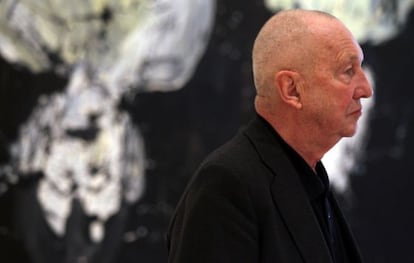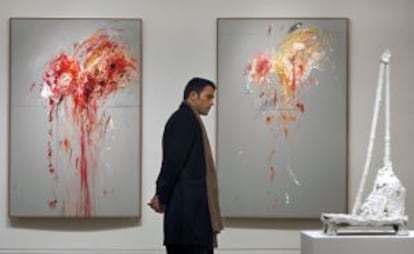Tyrants unite in Bilbao
Despotic works by Cy Twombly and Georg Baselitz face off at the Guggenheim Bilbao

The Guggenheim Bilbao is to pit two of the most important series in its collection against each other for a new joint exhibition starting next week. Historias de la Historia (Histories of history), curated by the museum's director of artistic activities, Petra Joos, features an artistic face-off between Mrs Lenin and the Nightingale (2008) by German painter Georg Baselitz and Discourses on Commodus (1963) by American artist Cy Twombly, two paintings featuring "personal narratives that revise historical figures from two separate periods in time, filled with body language."
The Baselitz work comprises 16 large-format paintings, divided into two groups of eight. The first features paintings in a range of grays on a black background, while the second are in color. Their departure point is an image of a fictitious encounter between Lenin and Stalin. The 16 works make reference to the 15 republics that made up the former Soviet Union plus the former East Germany, while the bird in the title alludes to a poem by German writer Johannes R. Becher in which Stalin is described as being like a nightingale.

Painted in Rome 50 years ago, Twombly's Discourses on Commodus comprises nine canvases that mix oils, pencil and wax crayons. The museum acquired the work in 2007 for 21 million euros, making it the most expensive piece in its collection. Until then it had been in the hands of a collector since its creation, and only ever shown in public once. Twombly was fascinated by ancient history and was inspired to create the work by the Roman Emperor Commodus, a tyrant who ended up assassinated.
The exhibition shows how the work of Twombly and Baselitz differs from that of so many other contemporary artists who appropriate history in order to refocus or reinterpret reality. Rather than revising historical events, the pair create stories based on historical facts and told from their own point of view. In this way, their provocations have a place within the artistic process and not on the political stage.
Historias de la Historia . January 22 to May 19 at Guggenheim Bilbao, Avenida Abandoibarra 2, Bilbao. www.guggenheim-bilbao.es
Tu suscripción se está usando en otro dispositivo
¿Quieres añadir otro usuario a tu suscripción?
Si continúas leyendo en este dispositivo, no se podrá leer en el otro.
FlechaTu suscripción se está usando en otro dispositivo y solo puedes acceder a EL PAÍS desde un dispositivo a la vez.
Si quieres compartir tu cuenta, cambia tu suscripción a la modalidad Premium, así podrás añadir otro usuario. Cada uno accederá con su propia cuenta de email, lo que os permitirá personalizar vuestra experiencia en EL PAÍS.
¿Tienes una suscripción de empresa? Accede aquí para contratar más cuentas.
En el caso de no saber quién está usando tu cuenta, te recomendamos cambiar tu contraseña aquí.
Si decides continuar compartiendo tu cuenta, este mensaje se mostrará en tu dispositivo y en el de la otra persona que está usando tu cuenta de forma indefinida, afectando a tu experiencia de lectura. Puedes consultar aquí los términos y condiciones de la suscripción digital.
Últimas noticias
Maduro pleads not guilty before the federal court in New York: ‘I am still the president of Venezuela’
A new test can detect Alzheimer’s from a finger prick
UN team enters Sudanese city of El Fasher after paramilitary massacre: ‘It’s like a ghost town’
A recipe for resistance: Indigenous peoples politicize their struggles from the kitchen
Most viewed
- Gilles Lipovetsky: ‘If you want to live better and fall in love, take Prozac, don’t look to philosophy’
- Alain Aspect, Nobel laureate in physics: ‘Einstein was so smart that he would have had to recognize quantum entanglement’
- Alvin Hellerstein, a 92-year-old judge appointed by Bill Clinton, to preside over Maduro’s trial in New York
- Maduro’s downfall puts China’s relationship with Venezuela to the test
- Why oil has been at the center of Venezuela-US conflicts for decades








































